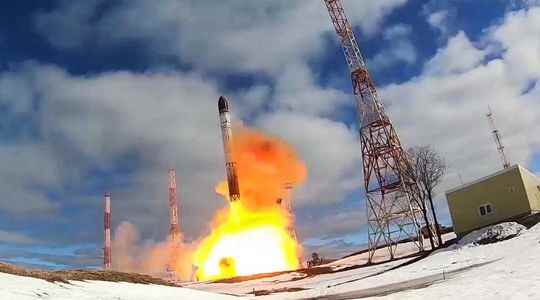Struggling on the Ukrainian theatre, Putin flexes his muscles. By announcing on Wednesday April 20 the first successful test firing of his RS-28 Sarmat intercontinental ballistic missile (ICBM) – nicknamed Satan 2 by Westerners – the Russian President did not hesitate to once again raise the specter of the nuclear threat. “It really is a unique weapon […] which will make those who try to threaten our country with raging and aggressive rhetoric think twice,” the Kremlin leader boasted during an address on Russian television.
With a range of 18,000 kilometers, this missile can reach a speed of 7 kilometers per second and carry on board up to 10 nuclear warheads, according to Russia. “Each of them can strike at different places in a territory. A missile carrying ten nuclear warheads would result in as many impacts on the targeted country”, explains Emmanuelle Maitre, research fellow at the Foundation for Strategic Research (FRS ), a specialist in deterrence issues. Is this a revolution?
“A kind of gesticulation intended to impress”
Concretely, the Sarmat is intended to replace position for position the SS-18, a previous generation of ICBM developed in the 1960s by the Soviet Union. As early as 2016, when the first images of Sarmat were broadcast, the Russian media did not fail to praise its ability to “annihilate territories the size of Texas or France”. Two years later, Putin presented it as part of a fifth generation of “invincible” missiles, including among others the Avangard hypersonic glider, capable of peaking at Mach 27, or more than 33,000 km / h.
“It seems that the capabilities of the Sarmat missile have been improved compared to those of its predecessor, particularly in terms of precision and penetration of anti-missile defenses. However, none of this will change the strategic balance with Western countries, underlines Admiral Jean-Louis Lozier, adviser to the Center for Security Studies at the French Institute for International Relations (Ifri) and former wing admiral The SS-18 could already be equipped with ten nuclear warheads and had overall the same All the communication made around the RS-28 is therefore more a kind of gesticulation intended to impress Western public opinion, than a real strategic upheaval.
The principle of nuclear deterrence
Despite its impressive technical sheet, the Sarmat test did not in fact arouse any alarmism in Western chancelleries. In the process, the spokesman for the Pentagon, John Kirby, simply indicated that it was a “routine” test that did not constitute “a threat” for the United States and its allies.
In addition, Moscow had previously “appropriately informed” Washington of the realization of this test, as provided for in the nuclear treaties. In this case, the use of ICBMs is framed by the New Start treaty, relating to the reduction of strategic nuclear weapons, signed between Russia and the United States in 2010. This caps the number of ballistic missiles at 700. intercontinental and 1550 the number of nuclear warheads that can be deployed there.
In addition, like Russia, the United States also has its own ICBM, the Minuteman III, as well as strategic bombers and nuclear-powered ballistic missile submarines (SNLE). In the same way, the M51 missiles, with which the French SSBNs are equipped, can also contain several nuclear warheads. “Russia has had the ability to send nuclear missiles to France, Europe or the United States since the 1950s. But we also have nuclear deterrence, so they don’t have the idea to use it against us”, summarizes Admiral Lozier.
For Putin, the hype around testing his new missile still has the advantage of diverting, at least partially, attention from his troubles in Ukraine, such as his failure to take the capital kyiv, or the sinking of his cruiser Moskva in the Black Sea mid-April. However, there is little risk that his new machine will be of any use to him in the conflict. “This missile is designed for retaliatory nuclear strikes over intercontinental distances, in the event of an attack against Russia, points out Emmanuelle Maitre. Which in no way corresponds to the Ukrainian theater.”
